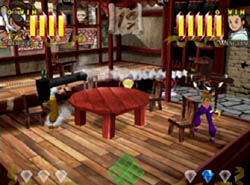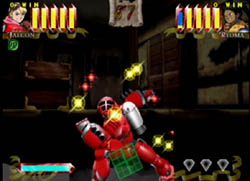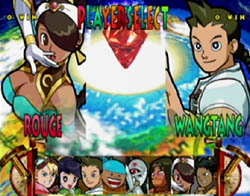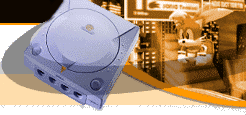| |
Power Stone
Not Your Daddy's Fighting Game - Review By Mix
 Capcom knows fighting games. They essentially invented the genre and have proven time and again that they are the masters of 2D fighters. They haven't always excelled with their forays into 3D fighting such as Namco and Sega have, but with Power Stone, they've produced a solid and fun title. Capcom knows fighting games. They essentially invented the genre and have proven time and again that they are the masters of 2D fighters. They haven't always excelled with their forays into 3D fighting such as Namco and Sega have, but with Power Stone, they've produced a solid and fun title.
Power Stone is set in the 19th century, with fighters from all over the world in search of the ultimate source of energy in the world, the Power Stone. There are eight characters, each with different moves and abilities. Some are fast, agile scrappers whose speed is their best defense, along with the large, hulking towers who can rip posts out of the ground and swing them like a baseball bat.
The Good

In Power Stone, nearly every object can be used as a weapon. |
Power Stone is probably the most versatile fighter ever. Pick up a table and toss it at your opponent, swing around a pole and launch into a flying kick that hits for big damage, or use one of the available weapons such as the flamethrower to reduce your enemy to ash. And that's not even half the moves available. You have regular punches and kicks, but the real goal is to collect three gems to turn into a supernatural version of your character and unleash a volley of super powered attacks. This mode only lasts a few moments, and while you're invulnerable to most standard attacks, you can still be thrown. Each combatant begins the round with one gem, and the third gem teleports in after a short time. To get all three, you must beat your opponent's gems out of them. This adds a bit of tension, as your trying to keep possession of your gems while trying to steal your enemy's and at the same time pick up any others lying around.
The graphics in this game are fantastic. Capcom chose to keep an anime style throughout. The characters, even though they are fully 3D, retain a 'cartoony' feel. The environments are very detailed, although small. One example is Falcon's level, where you can even read the menu items on a sign in front of a pub. Effects are what we have grown to expect from a next generation game, but with Capcom flare. The punches and kicks are punctuated with flashes reminiscent of Capcom's 2D games such as Marvel vs. Capcom. The super moves vary from Falcon's swarm of missiles that would make Robotech's Rick Hunter drool, to Rouge's 'Love Tent', where she pummels her helpless prey incessantly.

Getting the Power Stones supercharges your character. |
The game has a large difficulty scale that ranges from fairly easy, all the way to insane, and everything in between. At the easy level the computer opponents tend to miss obvious objects, fail to realize they must jump to grab a gem, or let the time run out on their powered-up form while they insist on hurling stuff at you. On the highest difficulty, they make few mistakes. However, even on the easiest level, don't expect to breeze through to the end, as the computer is a worthy opponent. This is a challenging game.
Sound is sufficiently beefy, with each hit accompanied by the appropriate pows, grunts, and snaps. The music is orchestral and dramatic, and suitably reflects the 19th century theme. Also worth mentioning are the numerous extra bonuses that can be gained. As you beat the game numerous times, new items, new playable characters, artwork, and even three VMS mini-games become available. You can check your progress in the 'Power Stone Collection,' a book whose pages describe your newfound options. This aspect of the game adds to its charm and replayability.
The Bad

Power Stone's anime-influenced style may be a turnoff to some. |
With Power Stone's innovation comes initial frustration (say that five times fast!). Because there are some many things to be aware of: Flying objects, new items to use, your opponents coming from all directions, etc., the game can be a bit daunting to the uninitiated. It takes some time to become accustomed to the controls. While this isn't a major flaw in design on Capcom's part (The control scheme is still very simple for the amount of things you can do), it is worth mentioning in this review since is will affect how easily a person can get into the game.
The character textures in Power Stone, although very colorful, seem somewhat pixilated up close. When compared to other fighting games such as Soul Calibur (which arguably has less detailed environments), the characters' textures seem fairly blocky. This is most noticeable on Falcon's jacket. The emblem on his back is totally unrecognizable. This is a stark contrast to the detail seen in the arenas.
Although the game has a lot of unlockable hidden options such as the third person view (the camera stays locked behind you), it would have been nice to see a few more battle modes. Noticeably missing was Team Battle, which is fast becoming a staple in the fighting genre. Also, the characters might be interesting, but there were too few of them. With other fighting games topping out in the fifteen to twenty-character range, Power Stone's eight playable characters seems somewhat paltry.
Power Stone was made for a Japanese audience, and it is most apparent in the sound. The voices and ending sequence narration is in Japanese, and while some people will not be bothered by this, it does somewhat inhibit Power Stone from gaining mass-market appeal, especially in the States. Non-anime fans will most likely be put off by the distinct Japanese style of the game.
The Final Word
Deep fighting games that deliver a truly enjoyable experience are a rare breed. Capcom shows its prowess in the genre as well as the power of the Dreamcast in Power Stone. Even if you don't like traditional fighters, give Power Stone a chance. It's uniqueness, versatility, and charm are enough to win over even the most jaded of gamers.
Developer: Capcom
Publisher: Capcom
Genre: Fighting
Highs: Innovative gameplay, gorgeous graphics, replayability with unlockable options, decent sound, VMS mini-games, interesting characters.
Lows: Initially difficult controls, blocky character textures, too few characters, lack of additional fighting modes, may be somewhat culturally distant for some players.
Other: 1-2 Players, VMU Compatible (save game and mini-games), Jump Pack Compatible, Arcade Stick Compatible.
|
Final Score:

(out of a possible 10)
|
Visit this Game's Dreamcast Database Entry
Previous Reviews
Comments on this review? Mail Feedback.
|

